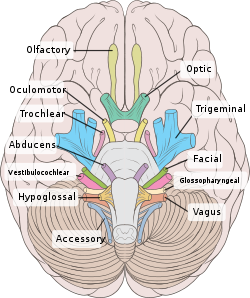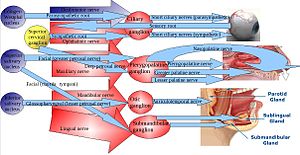- Cranial nerve
-
Nerve: Cranial nerves 
Inferior view of the brain and brain stem showing cranial nerves. An unlabelled version is here Latin nervus cranialis (plural: nervi craniales) Code TA A14.2.00.038 Cranial nerves are nerves that emerge directly from the brain, in contrast to spinal nerves, which emerge from segments of the spinal cord. In humans, there are traditionally twelve pairs of cranial nerves. Only the first and the second pair emerge from the cerebrum; the remaining ten pairs emerge from the brainstem.
Contents
Cranial nerves in non-human vertebrates
Human cranial nerves are nerves similar to those found in many other vertebrates. Cranial nerves XI and XII evolved in other species to amniotes (non-amphibian tetrapods), thus totaling twelve pairs. In some primitive cartilaginous fishes, such as the spiny dogfish or mud shark (Squalus acanthias), there is a terminal nerve numbered zero, since it exits the brain before the traditionally designated first cranial nerve. Because they exit from the brainstem as opposed to the spinal column, these are part of the central nervous system.
List of cranial nerves
Number Name Sensory,
Motor
, or BothOrigin Nuclei Function 0 Cranial nerve zero (CN 0 is not traditionally recognized[1].) Sensory olfactory trigone, medial olfactory gyrus, and lamina terminalis New research indicates that CN 0 may play a role in the detection of pheromones [2][3]. It is linked to the olfactory system in human embryos[4].
I Olfactory nerve Purely Sensory Telencephalon Anterior olfactory nucleus Transmits the sense of smell. Located in olfactory foramina in the cribriform plate of ethmoid. II Optic nerve Purely Sensory Diencephalon Ganglion cells of retina[5] Transmits visual information to the brain. Located in the optic canal. III Oculomotor nerve Mainly Motor Anterior aspect of Midbrain Oculomotor nucleus, Edinger-Westphal nucleus Innervates the levator palpebrae superioris, superior rectus, medial rectus, inferior rectus, and inferior oblique, which collectively perform most eye movements. Also innervates the sphincter pupillae and the muscles of the ciliary body. Located in the superior orbital fissure. IV Trochlear nerve Mainly Motor Dorsal aspect of Midbrain Trochlear nucleus Innervates the superior oblique muscle, which depresses, rotates laterally, and intorts the eyeball. Located in the superior orbital fissure. V Trigeminal nerve Both Sensory and Motor Pons Principal sensory trigeminal nucleus, Spinal trigeminal nucleus, Mesencephalic trigeminal nucleus, Trigeminal motor nucleus Receives sensation from the face and innervates the muscles of mastication. Located in the superior orbital fissure (ophthalmic nerve - V1), foramen rotundum (maxillary nerve - V2), and foramen ovale (mandibular nerve - V3). VI Abducens nerve Mainly Motor Posterior margin of Pons Abducens nucleus Innervates the lateral rectus, which abducts the eye. Located in the superior orbital fissure. VII Facial nerve Both Sensory and Motor Pons (cerebellopontine angle) above olive Facial nucleus, Solitary nucleus, Superior salivary nucleus Provides motor innervation to the muscles of facial expression, posterior belly of the digastric muscle, and stapedius muscle. Also receives the special sense of taste from the anterior 2/3 of the tongue and provides secretomotor innervation to the salivary glands (except parotid) and the lacrimal gland. Located in and runs through the internal acoustic canal to the facial canal and exits at the stylomastoid foramen. VIII Vestibulocochlear nerve (or auditory-vestibular nerve or statoacoustic nerve) Mostly sensory Lateral to CN VII (cerebellopontine angle) Vestibular nuclei, Cochlear nuclei Senses sound, rotation, and gravity (essential for balance and movement). More specifically, the vestibular branch carries impulses for equilibrium and the cochlear branch carries impulses for hearing. Located in the internal acoustic canal. IX Glossopharyngeal nerve Both Sensory and Motor Medulla Nucleus ambiguus, Inferior salivary nucleus, Solitary nucleus Receives taste from the posterior 1/3 of the tongue, provides secretomotor innervation to the parotid gland, and provides motor innervation to the stylopharyngeus. Some sensation is also relayed to the brain from the palatine tonsils. Located in the jugular foramen. X Vagus nerve Both Sensory and Motor Posterolateral sulcus of Medulla Nucleus ambiguus, Dorsal motor vagal nucleus, Solitary nucleus Supplies branchiomotor innervation to most laryngeal and pharyngeal muscles (except the stylopharyngeus, which is innervated by the glossopharyngeal). Also provides parasympathetic fibers to nearly all thoracic and abdominal viscera down to the splenic flexure. Receives the special sense of taste from the epiglottis. A major function: controls muscles for voice and resonance and the soft palate. Symptoms of damage: dysphagia (swallowing problems), velopharyngeal insufficiency. Located in the jugular foramen. XI Accessory nerve (or cranial accessory nerve or spinal accessory nerve) Mainly Motor Cranial and Spinal Roots Nucleus ambiguus, Spinal accessory nucleus Controls the sternocleidomastoid and trapezius muscles, and overlaps with functions of the vagus nerve (CN X). Symptoms of damage: inability to shrug, weak head movement. Located in the jugular foramen. XII Hypoglossal nerve Mainly Motor Medulla Hypoglossal nucleus Provides motor innervation to the muscles of the tongue (except for the palatoglossus, which is innervated by the vagus nerve) and other glossal muscles. Important for swallowing (bolus formation) and speech articulation. Located in the hypoglossal canal. Mnemonic devices
As the list is important to keep in mind during the examination of the nervous system, there are many mnemonic devices in circulation to help remember the names and order of the cranial nerves. Because the mind recalls rhymes well, the best mnemonics often use rhyming schemes.
Six of the best known examples are:
"Oh Once One Takes The Anatomy Final, Very Good Vacations Are Had",
"On Old Olympus's Towering Tops, A Fine-Vested German Viewed Some Hops"
"Oh, Oh, Oh To Take A Family Vacation! Go Vegas After Hours!",
"Oh, Oh, Oh, To Touch And Feel Very Good Velvet, Ahh, Heaven"
"Oh, Oh, Oh, To Touch And Feel Veins Going Vertically And Horizontally".
A useful mnemonic for remembering which nerves are motor (M), sensory (S), or both (B) is, "Some Say Money Matters But My Brother Says Big Brains Matter Most". There are many more mnemonics from many sources, for example OLd OPie OCcasionally TRies TRIGonometry And Feels VEry GLOomy, VAGUe, And HYPOactive.[6]See also
References
- ^ Fuller GN, Burger PC (1990). "Nervus terminalis (cranial nerve zero) in the adult human". Clin. Neuropathol. 9 (6): 279–83. PMID 2286018.
- ^ Meredith M (May 2001). "Human vomeronasal organ function: a critical review of best and worst cases". Chem. Senses 26 (4): 433–45. doi:10.1093/chemse/26.4.433. PMID 11369678. http://chemse.oxfordjournals.org/cgi/content/full/26/4/433.
- ^ Fields, R. Douglas (February 2007). "Sex and the Secret Nerve". Scientific American Mind. http://www.sciammind.com/article.cfm?articleID=792DDD7C-E7F2-99DF-397429B8BB8ED7ED&ref=sciam.
- ^ Müller F, O'Rahilly R (2004). "Olfactory structures in staged human embryos". Cells Tissues Organs (Print) 178 (2): 93–116. doi:10.1159/000081720. PMID 15604533.
- ^ Henry Gray (1821–1865). Anatomy of the Human Body. 1918.
- ^ Saladin, Kenneth S. (2008). Human anatomy (2nd ed.). McGraw-Hill Higher Education. ISBN 0071102094.
Nervous system (TA A14, GA 9) Central nervous system Peripheral nervous system Nerves of head and neck: the cranial nerves and nuclei (TA A14.2.01, GA 9.855) olfactory (AON->I) optic (LGN->II) oculomotor
(ON, EWN->III)trochlear (TN->IV) no significant branchestrigeminal
(PSN, TSN, MN, TMN->V)abducens (AN->VI) no significant branchesfacial (FMN, SN, SSN->VII) near originvestibulocochlear
(VN, CN->VIII)glossopharyngeal
(NA, ISN, SN->IX)before jugular fossaafter jugular fossavagus
(NA, DNVN, SN->X)before jugular fossaafter jugular fossaaccessory (NA, SAN->XI) hypoglossal (HN->XII) Categories:
Wikimedia Foundation. 2010.

